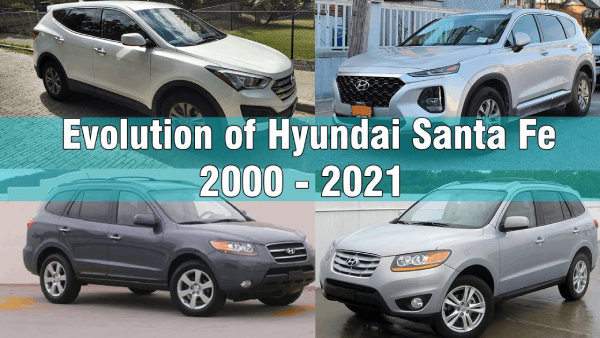The Hyundai Santa Fe, a name synonymous with versatility, comfort, and innovation, has been a key player in the SUV market since its debut in 2000. Over more than two decades, Hyundai has continuously evolved the Santa Fe, blending rugged capability with urban sophistication, offering something for everyone from families to adventure seekers.
This comprehensive guide explores every generation of the Hyundai Santa Fe, diving deep into its design evolution, interior features, engine options, and technical details. Whether you are considering purchasing a new model or simply want to understand its legacy, this article covers everything you need to know.
Table of Contents
- Introduction to Hyundai Santa Fe
- 2023: Fifth-Generation Hyundai Santa Fe
- 2020 Refresh and the 20th Anniversary
- 2018 Fourth Generation Hyundai Santa Fe
- Earlier Generations Overview (2012-2017)
- Santa Fe Sport (2016-2018)
- Technical Details and Engine Options
- History of Hyundai Santa Fe (2000–2016)
- Conclusion
Introduction to Hyundai Santa Fe
Launched in 2000, the Hyundai Santa Fe marked Hyundai’s ambitious entry into the competitive SUV market. Designed initially as a practical, affordable alternative to traditional SUVs, the Santa Fe caught on quickly due to its blend of car-like comfort and SUV utility. It has since grown into a mid-size SUV powerhouse that competes with premium brands at a fraction of the price, making it a favorite among families and outdoor enthusiasts alike.
2023: Fifth-Generation Hyundai Santa Fe
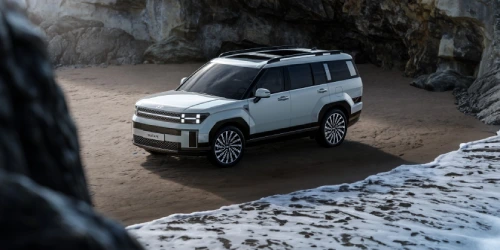
Bold New Design
In 2023, Hyundai unveiled the fifth generation of the Santa Fe, which stunned the automotive world with a daring and completely fresh design language. This iteration is larger, more luxurious, and packed with high-end features, yet it remains a mass-market SUV suited for both urban commutes and outdoor adventures.
- Front Fascia: The new Santa Fe sports a flat, aggressive front fascia with a wide light strip running across the main grille, seamlessly connecting to uniquely positioned headlights. Gone are the smooth, rounded curves of the past, replaced by chopped, straight lower grilles and side intakes.
- Body Lines: Flared wheel arches add to its rugged, off-road-ready appearance, while the roofline subtly slopes downward to enhance its dynamic stance.
- Rear Design: Though the rear fascia is less striking, featuring a light strip overlapping the tailgate, the design prioritizes function over form, offering excellent interior space.
Interior and Technology
The 2023 Santa Fe’s interior caters to those who enjoy outdoor camping without sacrificing everyday comfort.
- Spacious Cabin: The nearly vertical side panels and long roofline create ample room. Folding the second and third rows flat creates a level sleeping surface for at least two adults.
- Dashboard: The centerpiece is a panoramic curved display combining a 12.3-inch touchscreen infotainment system and a digital instrument cluster — both housed behind the same glass panel.
- Controls: Critical HVAC and audio controls retain physical buttons, ensuring ease of use while driving.
Hybrid Powertrains
Hyundai offers two hybrid variants in the new Santa Fe, both powered by either a 1.6-liter or 2.5-liter gasoline engine paired with electric motors. These hybrid drivetrains are derived from the previous generation’s proven technology, balancing power and fuel efficiency.
2020 Refresh and the 20th Anniversary
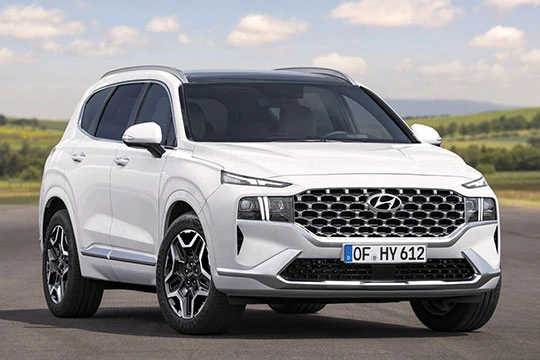
To celebrate two decades of the Santa Fe, Hyundai introduced significant updates in 2020, barely three years after the fourth generation debuted.
Exterior Enhancements
- Design: The refreshed Santa Fe blends elegant lines and tough elements with a unique 3D wide grille and T-shaped LED daytime running lights.
- Bumper and Wheel Arches: A shield-shaped element beneath the lower air inlet and body-colored plastic moldings on the wheel arches gave the SUV a refined yet robust look.
- Wheels: Optional 20-inch alloy wheels were offered to enhance road presence.
Interior Upgrades
- Space: The new D-platform increased cabin space, especially benefiting backseat passengers.
- Technology: The driver could opt for a 12.3-inch digital instrument cluster, while a 10.25-inch touchscreen infotainment system adorned the center stack.
- Dashboard: Redesigned for an airy feel, the lower dashboard improved passenger comfort.
2018 Fourth Generation Hyundai Santa Fe
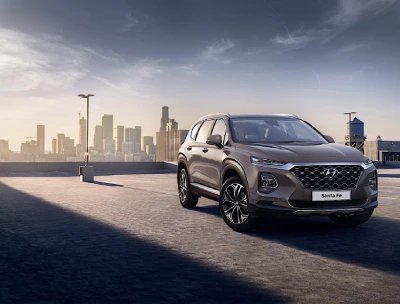
Design and Trim Levels
The 2018 Santa Fe introduced sharper, more contemporary lines and came in three trims: SE, SE Ultimate, and Limited Ultimate. It offered three rows of seating with a capacity for seven passengers.
- Exterior: The front fascia included a redesigned cascade grille flanked by headlights with distinctive daytime running lights (DRLs).
- Interior: Offered leather upholstery, a sunroof, heated and ventilated seats, and upgraded infotainment screens varying by trim.
diesel engines:
- 2.0L CRDI 6MT AWD HYUNDAI Santa Fe (150 HP)
- The 2.0L CRDI 6MT AWD HYUNDAI Santa Fe (185 HP)
- The 2.0L CRDI 6MT FWD HYUNDAI Santa Fe (150 HP)
- The 2.0L CRDI 6MT FWD HYUNDAI Santa Fe (185 HP)
- The 2.0L CRDI 8AT AWD HYUNDAI Santa Fe (150 HP)
- The 2.0L CRDI 8AT AWD HYUNDAI Santa Fe (185 HP)
- 2.2L CRDi 6MT AWD HYUNDAI Santa Fe (200 HP)
- 2.2L CRDi 8AT AWD HYUNDAI Santa Fe (200 HP)
- 2.2L CRDi 8AT FWD HYUNDAI Santa Fe (200 HP)
gasoline engines:
- 2.4L 8AT AWD HYUNDAI Santa Fe (185 HP)
Technology and Safety
- Infotainment: Standard 7-inch touchscreen with Android Auto and Apple CarPlay.
- Safety: Optional Tech Package with adaptive cruise control, forward collision avoidance, lane departure warning, and automatic high beams.
- Comfort: Heated front seats standard, reclining 60/40 split-folding rear bench, and a head-up display option.
Earlier Generations Overview (2012-2017)
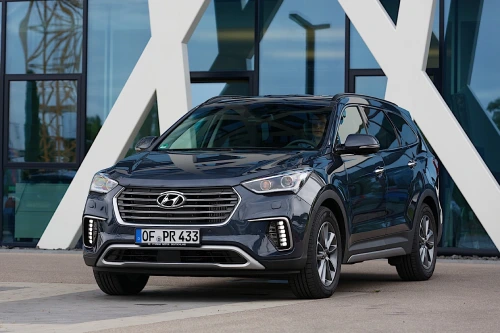
The Santa Fe continued to evolve with improved tech, safety, and comfort features. Notably, the 2017 model offered four trim levels—SE, Limited, SE Ultimate, and Limited Ultimate—with various luxury and convenience upgrades such as
- 19-inch alloy wheels
- Panoramic sunroof
- Advanced driver assistance systems
- Infotainment system with Hyundai Blue Link connectivity
Santa Fe Sport (2016-2018)
A unique US-market variant known as the Santa Fe Sport featured:
- Exterior: Updated bumpers, HID Xenon headlights with LED accents, LED daytime running lights, and redesigned rear taillights.
- Interior: 12-speaker Infinity Logic7 sound system, panoramic sunroof, and touchscreen infotainment with Android Auto.
- Powertrains: Offered 2.0L and 2.4L gasoline engines, with front-wheel or all-wheel-drive options.
Technical Details on Petrol Engines for Santa Fe Sport
EngineTransmissionDrive TypePower Output2.0L Turbo6-speed ATAWD/FWD 240 HP 2.4L 6-speed AT/MTAWD/FWD 185-188 HP
Diesel Engines
EngineTransmissionDrive TypePower Output2.0L CRDI6-speed MT/ATAWD/FWD150 HP 2.2L CRDI 6-speed MT/ATAWD/FWD 200 HP
Technical Details and Engine Options
Hyundai has offered a broad range of powertrains over the years, including gasoline, diesel, turbocharged, and hybrid options.
Petrol Engines
- 2.0L Turbocharged: Available with 6-speed automatic transmission, producing up to 264 HP.
- 2.4L Naturally Aspirated: Offering around 185-190 HP.
- 3.3L V6: Found in higher trims, delivering up to 290 HP.
Diesel Engines
- 2.0L CRDI: Available with manual or automatic transmissions, producing between 150 and 184 HP.
- 2.2L CRDI: A popular European variant, offering 200 HP with advanced emission controls.
History of Hyundai Santa Fe (2000–2016)
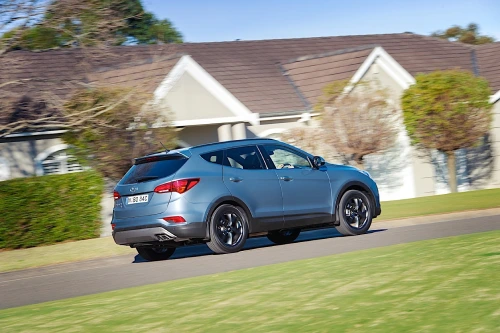
Third Generation (2012-2016)
Launched with a bold grille and muscular design, this generation emphasized comfort and technology.
- Interior: Available seven seats, Bluetooth, navigation, and reverse camera.
- Engines: The range included 2.2L diesel and 3.3L V6 petrol.
- Suspension: Independent all-wheel suspension for improved ride quality.
Second Generation (2006-2012)
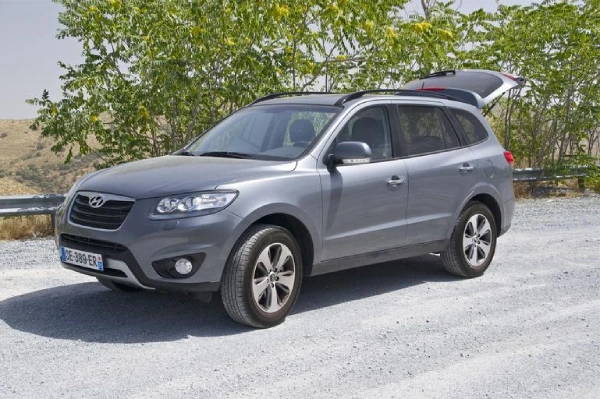
This generation introduced a more aggressive front fascia with sharper headlamps and a larger grille.
- Seating: Offered seven seats as an option.
- Engines: 2.7L V6 petrol and 2.2L turbo diesel.
- Drivetrain: Front-wheel or all-wheel drive options.
First Generation (2000-2006)
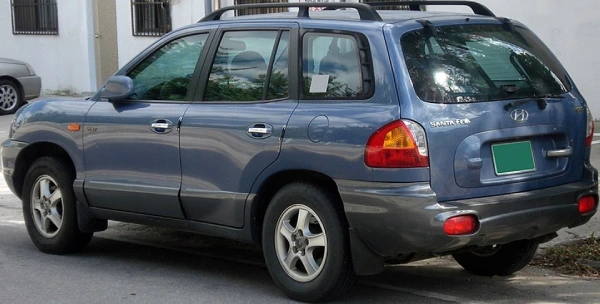
Hyundai’s first attempt at an SUV targeted buyers needing more space than sedans or wagons.
- Design: Simple, sedan-like with higher ground clearance.
- Interior: Spacious with air conditioning and a CD player standard.
- Engines: 2.4L petrol, 2.0L diesel turbo available in different markets.
Conclusion
The Hyundai Santa Fe has come a long way since its inception, evolving from a practical family SUV to a sophisticated, tech-laden mid-size SUV with hybrid options and bold styling. Each generation has introduced new features and improvements, making the Santa Fe a competitive choice for buyers seeking reliability, comfort, and advanced technology without the premium price tag.
Whether you need a spacious vehicle for family trips, a capable SUV for weekend adventures, or a stylish daily driver, the Hyundai Santa Fe offers a versatile package backed by decades of continuous refinement.
